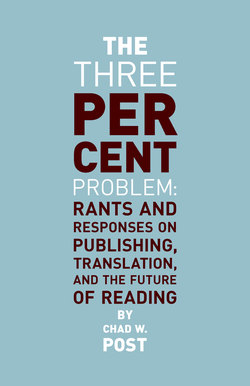Читать книгу The Three Percent Problem - Chad W. Post - Страница 20
На сайте Литреса книга снята с продажи.
Branding
for Publishers
ОглавлениеIn August 2007, Joe Wikert wrote an interesting post about publisher brands in response to a “post by Lissa Warren” on the Huffington Post.
Quick, name you favorite book. Now, quick, name who published it.
Gotcha, didn’t I?
It’s a bit cute, but Warren’s point is obvious—non-industry people don’t pay attention to who publishes what.
True, when browsing we may be mildly impressed by a title that has Knopf on the spine, or Norton, or Houghton, or Farrar, Straus and Giroux. We may select a Harvard University Press book over a similar one published by the University of God-Knows-Where. We may even smile and nod in recognition when we see that a collection of poetry has been put out by Copper Canyon or Graywolf Press. But I’d argue that recommendations by family and friends, and fabulous covers, and favorable reviews, and favorite authors are much more likely to catch our attention than a dolphin logo or a Borzoi silhouette.
And Joe Wikert backs her up:
Do you ever think about particular publishers when you’re looking for a book? If you’re like the vast majority of the book buying public this rarely if ever crosses your mind. You don’t care who the publisher is. You might be interested in the author or maybe the series but publisher names are a lot like record labels; they aren’t the primary (or even secondary!) brand on the product.
All this makes sense, especially when we’re talking about best-sellers or mainstream titles. Who really gives a shit whether Simon & Schuster or Penguin published French Women Don’t Get Fat? (It was Knopf.)
But I think the situation is different when you look at literary fiction and independent presses. Presses like New York Review Books, Archipelago, New Directions, Dalkey Archive, Soft Skull, Melville House, etc., all publish a certain type of book, and because of this, they all have loyal followings.
Record labels might be an apt comparison. Places like EMI or Columbia are so big and diffuse that the good music is mixed in with everything else, and the overall “brand” doesn’t mean anything. On the other hand, Matador, Merge, Thirsty Ear, Aum Fidelity—these labels have a focus, and I know what to expect from them. And yes, similar to the publishers mentioned above, I seek them out online and in stores to see what they’re up to this week.
